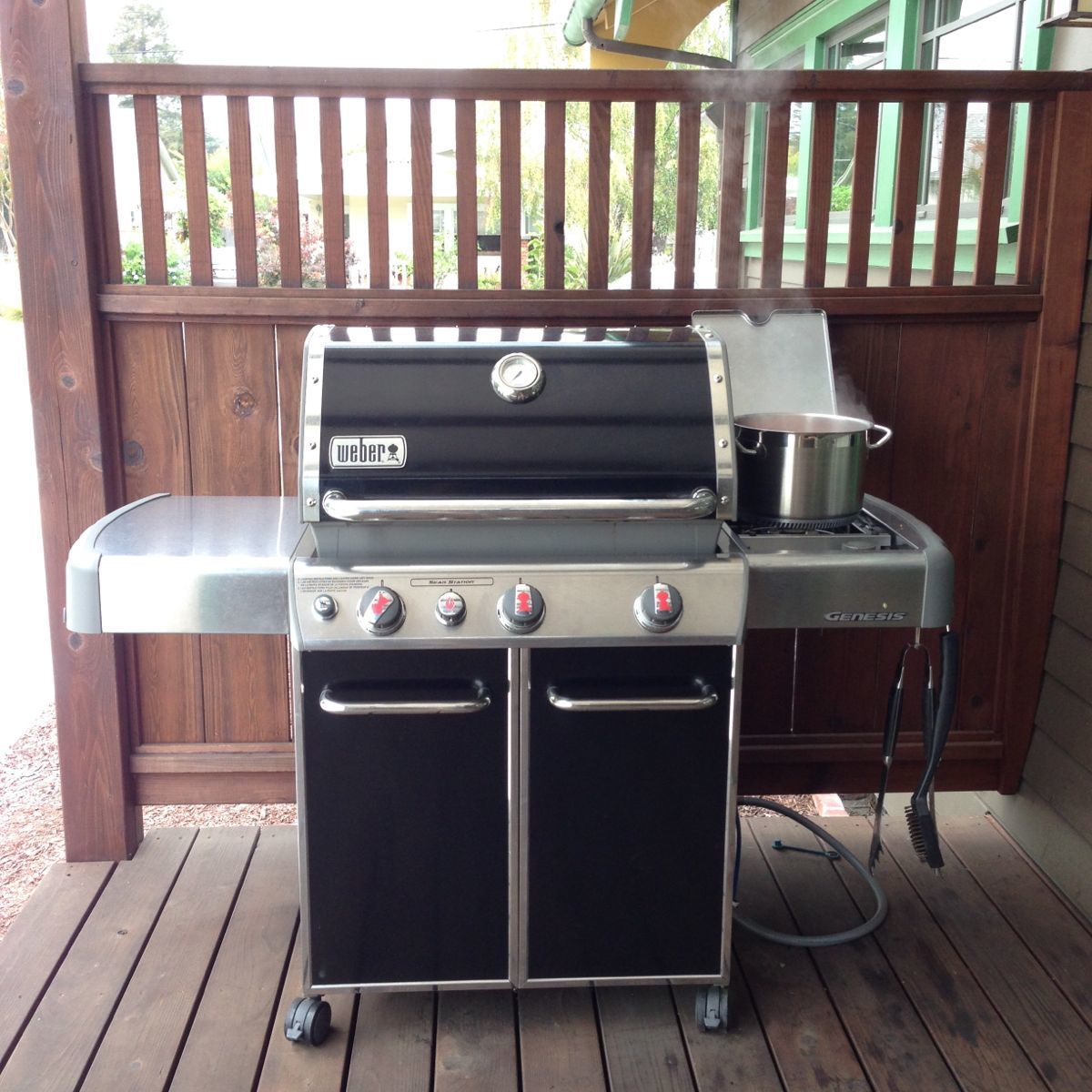Cooking with Gas Outside for Comfort and Health
"Gas appliance outside and electric appliances inside" was the guideline we used for making appliance decision during our remodel. Having both gas appliance and electric appliance made sense for us because Midori Haus was already plumbed with natural gas line for hot water heating. If this infrastructure connection was not in place we probably would not have natural gas appliances.
When we lived in our condo we had a gas barbecue fueled with propane. Although this was a lot more convenient and faster than using charcoal for outdoor barbecue it still required lugging around the propane tank to the service station few times a year to get it refilled. So we took an extra step towards convenience by having a outdoor barbecue unit that can take natural gas as a fuel source and had the gas plumbing line installed.
At Midori Haus we chose the Weber NG 54488 barbecue unit that has a side burner so we can simmer a large batch of apple sauce or make spaghetti outside and keep the heat out of the house during the hot summer months to prevent the house from overheating. Also the combustion byproducts from gas stays outside so the indoor air quality is better. Plus if there ever was power outage and putting our electric induction cooktop in the kitchen out of commission we can still have a hot meal if the gas service is on. If we truly wanted to be resilient and a bit more self reliant we could even get a solar oven.

What's better? Cooking with gas or electricity? It depends on what your decision is based on. I liked cooking with gas because it always felt fast and responsive. My husband used to impress me during our courtship days when he made his speciality dessert of bananas fried with brown sugar and bourbon. He would turn the lights off just before tipping the skillet ever so slightly towards the flame and igniting the bananas for a flashy finale. It wasn't until when I took the indoor air quality classes that I learned the burning that creates heat on the stove top (or gas oven) is a chemical reaction in which natural gas combines with oxygen. When there is not enough oxygen the combustion is incomplete and produces combustion byproducts. Prolonged exposure to combustion byproducts could cause flu-like symptoms. When we learned about this and appreciated the function of the kitchen vent hood (it wasn't simply to clear away the smell of the food odor) we paid closer attention to how we used the gas stove and our cooking routine at the old condo changed. Our cooking routine started with walking over to the front door to open a window by the stairs (because the kitchen had no windows) then walking back to the kitchen to turn on the vent hood then turning on the gas cooktop. When the cooking was done the reverse routine took place. If this was in the winter the rooms got colder from the outside air and the opposite happened during the summer. We opened the windows to provide a path for make-up-air to come into the house when the kitchen vent hood created negative air pressure. Our little routine to keep healthy indoor air quality had the effect of cooling and warming the indoor space. It was unfortunate that it often happened to be exactly opposite of the thermal comfort we wanted on our skin.
When we were designing Midori Haus we were really focused on using very little energy to be healthy and comfortable in our home. So we decided not to have any gas combustion appliances inside the house because the house would be practically airtight and we wanted the air to be as clean as possible. This meant the house would have no gas stove top, no gas oven, and no fireplace. Midori Haus is practically airtight, about 10 times tighter than most new homes built today. Having an airtight home saves energy by keeping the indoor temperature constant much longer than a drafty house. We chose not to have the vent hood in the kitchen evacuate the air outside. Instead we got a recirculating vent hood and had the Heat Recovery Ventilator (HRV) manage the ventilation.
During the late summer months when the abundance of fruits in the garden are begging to be preserved I can choose to cook on the induction cooktop inside the kitchen or on the gas stove outside on the deck. The kitchen can get pretty warm when making jam and sauces. This year I processed my tomato harvest by setting up a table on the kitchen deck and made tomato-jalapeno jam and marinara sauce on the gas stove attached to the barbecue. I spent several hours standing outside cutting, stirring, and simmering the tomatoes on the gas stove, which created lots of heat and combustion byproduct. Even if I was sweating outside in the 90-degree weathers slaving over the jam I smiled knowing that combustion byproducts stayed outside and I can be in the cool comfortable house with clean air just by stepping through the door.
About the Author
Chie Kawahara
Chie is one of the co-creator of Midori Haus. When she is not sharing her stories of transforming an old house and giving tours, she enjoys trail running and hiking.
Hi Chie
Am looking for an induction cooktop
Am confused between Nesco Portable Induction Cooktop Reviews – PIC-14, 1500-Watt and 1800-Watt DUXTOP Induction Cooktop reviews – Countertop Burner – 8100MC
What would you recommend and why?
Thanks
Mon